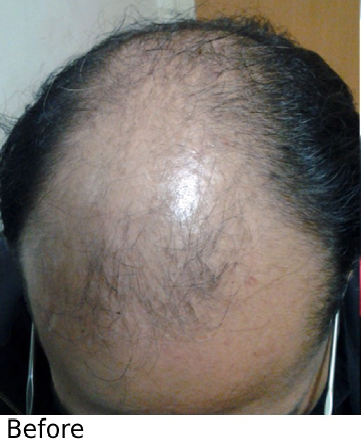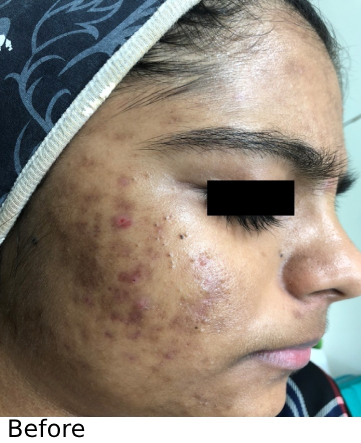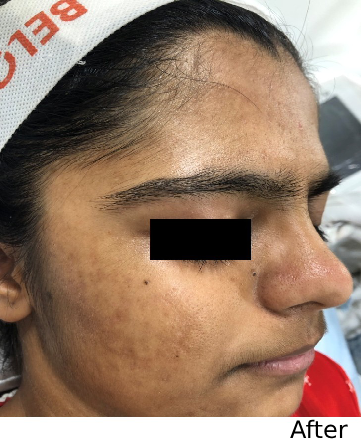
Loading...

Loading...
General Skin problem block
Hair care is an overall term for hygiene and cosmetology involving the hair which grows from the human scalp, and to a lesser extent facial, pubic and other body hair. Hair care routines differ according to an individual’s culture and the physical characteristics of one’s hair. Hair may be colored, trimmed, shaved, plucked or otherwise removed with treatments such as waxing, sugaring and threading. Hair care services are offered in salons, barbershops and day spas, and products are available commercially for home use. Laser hair removal and electrolysis are also available, though these are provided (in the US) by licensed professionals in medical offices or speciality spas.


A skin condition that occurs when hair follicles plug with oil and dead skin cells.


Laser hair removal is the process of hair removal by means of exposure to pulses of laser light that destroy the hair follicle. It had been performed experimentally for about twenty years before becoming commercially available in 1995 and 1996.


Tattoos naturally fade over time because the body’s immune system recognizes that tattoo ink is a foreign substance and tries to remove ink particles. Laser tattoo removal speeds up the natural process by shattering tattoo ink into smaller pieces that flush away more easily.
Tattoo removal is a procedure done to try to remove an unwanted tattoo. Common techniques used for tattoo removal include laser surgery, surgical removal and dermabrasion.
Tattoo ink is placed beneath the top layer of the skin. That makes tattoo removal more complicated — and expensive — than the original tattoo application.
Q-switched lasers — which release energy in a single, powerful pulse — are often the treatment of choice for tattoo removal. A special type of laser — called a Q-switched Nd:YAG — might be used on darker skin to avoid changing the skin’s pigment permanently.
Before laser treatment, the skin is numbed with an injection of a local anesthetic. Then a powerful pulse of energy is applied to the tattoo to heat and shatter the tattoo ink. Multicolored tattoos might need treatment with various lasers and different wavelengths.
After the procedure, you might notice swelling and possibly blistering or bleeding. Antibacterial ointment can help promote healing. You’ll likely need repeated sessions to lighten the tattoo, and it might not be possible to completely erase the tattoo.
During surgical removal, the skin is numbed with an injection of a local anesthetic. The tattoo is removed with a scalpel, and the edges of skin are stitched back together. After the procedure, antibacterial ointment helps promote healing.
Surgical tattoo removal is effective — but it leaves a scar and might be practical only for small tattoos.
During dermabrasion, the tattooed area is typically chilled until numb. Then the tattooed skin is sanded down to deeper levels with a high-speed rotary device that has an abrasive wheel or brush. This allows the tattoo ink to leach out of the skin.
The affected area feels sore and raw for several days after the procedure. Recovery can take up to two to three weeks. Due to unpredictable results and less effective outcomes than laser or a combination of laser and excision, dermabrasion isn’t a common choice.
Tattoos are meant to be permanent, and complete tattoo removal is difficult. Some degree of scarring or skin color variation is likely to remain, regardless of the specific method of tattoo removal.
A chemical peel is a skin-resurfacing procedure in which a chemical solution is applied to the skin to remove the top layers. The skin that grows back after a chemical peel is smoother and younger looking.
Chemical peels are used to treat wrinkles, skin discoloration and scars — typically on the face. A chemical peel can be done alone or in combination with other cosmetic procedures.
Chemical peels can be done at different depths — light, medium or deep — depending on your desired results. Each type of chemical peel uses a different chemical solution. Deeper chemical peels produce more-dramatic results, but also involve longer recovery times


Skin polishing generally refers to a technique to improve the skin, its texture, improve acne, fine lines and spots around the skin. It is a way to improve your skin by making it more smoother, brighter and softer. The skin becomes more radiant as the dead skin is removed by killing the dead cells. This is a great method to reverse skin damage.
It can be carried out at home or at the dermatologist’s clinic. It should also never be performed without the advice of a skin expert.
This treatment requires the individual to attend various sessions and the skin is polished every time to make it look more appealing. It is widely used to provide the skin with the nutrition it lacks, and the dead skin cells are efficiently removed.
This treatment is safe and suitable for all skin types and the peeling method or dermabrasion is gentle and highly effective on the skin, nurturing the skin with every session. It is not a long process, consuming around 45 minutes in one session. There are barely any side effects to this treatment, as the skin is exposed to making it better in appearance and feel. The skin might undergo a temporary redness after the session, which wears off as the time passes.
Skin polishing is not only limited to the face and can be used on the neck, back and even the hands. Stretch marks, hyperkeratosis, scars, disorders, pigmentation, uneven skin etc., can be immediately cured with the skin polishing technique which promises a lifetime of healthy appearance, from the inside and out.
Looking good does wonders for the inner self. It improves our face value, builds our confidence & helps us be successful in every field. Medical science now makes it possible to renew our youthful appearance. Wrinkles are the primary lines of concern. They are formed on the face over time due to sun exposure & continuous muscle activity. These lines can often make us look tired, angry or older than we are.Botulinum Toxin is one of the best & the most popular wrinkle reduction treatment available today.
Botulinum Toxin is a natural purified protein approve by US FDA & is used to relax the muscles which cause wrinkles. Usually injected to reduce frown lines on forehead & crows feet around eyes. Effect lasts for 3-6 months.


A filler treatment is a cosmetic dermatological procedure that is used to minimize the appearance of facial lines and wrinkles to restore a youthful look. It is a great treatment option for those who want to eliminate the signs of aging but are not willing to undergo invasive treatments such as a traditional facelift. It works by filling up areas of the face that are prone to sagging to bring back its natural volume and fullness. Although it does not bring permanent results, it offers a simpler, safer, and cheaper way to look younger.
A dermal filler treatment is most beneficial for patients who have the following signs of skin aging:
On the other hand, a filler treatment is not safe for those who:
The fillers are expected to temporarily smooth out surface flaws on facial skin. The length of time the results are expected to last may differ depending on the specific product used.
Since the fillers are only injected into the skin, the treatment does not require a long recovery and downtime. Patients can safely go back to their normal routine after the procedure, as long as they avoid strenuous activities and excessive sun exposure. Meanwhile, normal post-procedure symptoms are expected to go away after a couple days.
A dermal filler works by raising or puffing up particular areas of the face. It is most commonly used in areas that succumb to sagging skin, which creates a hollowed look. The specific manner as to how the procedure works depends on the type of fillers being used. Existing options include:
A filler treatment can be carried out by a dermatologist or a cosmetic surgeon. Regardless of which material is used as the filling agent, a greater part of the process is generally the same. The patient first receives a local anesthesia to numb the facial area. Once the anesthesia has settled in, the surgeon or dermatologist injects the filler into the predetermined area, just under the skin. For fat graft, however, the fat that will be used as the filling agent is first harvested from another part of the body.
Each procedure will take approximately 15 minutes. However, depending on the severity of the condition and the size of the treatment area, succeeding sessions may be necessary. If so, each session is spaced at least two weeks apart.
As we age, the rate of loss of the old skin cells from the uppermost layer of the skin (stratum corneum) slows down. The skin gradually gets less translucent and does not retain water so well. All the skin functions take place more slowly in mature skin. Collagen and elastin fibres which form the framework of the skin begin to loosen.This is intrinsic aging. Extrinsic aging primarily occurs due to UV Rays. As most of us have been exposed to the sun to a greater or lesser degree over many decades, the ‘damage’ to the dermis can be seen even through the dry epidermis as we age. Other causes of extrinsic aging are Chemical pollutants, Poor nutrition, starvation diets, Physical & mental stress, Smoking,Alcohol ,Inadequate sleep & lack of exercise.
The rate at which our skin changes is dependent to some extent on what we inherited in the first place, how we treated it and how we looked after it. A varied number of vitamins and minerals are necessary for healthy skin.Vitamin A prevents skin from becoming dry and flaky,vitamin C is important for the production of collagen and vitamin E helps to rehydrate the skin, damp down inflammation and speed up the healing process. Minerals and anti oxidants combat free radicles and help retain the youthfulness of skin. Proteins and biotin are required for healthy hair and nails. It is interesting to note that Water, Vegetables & fruits like watermelon, walnuts, Olive oil (antioxidant), fish like salmon & mackerel (omega 3 Fatty acid) are moisturizers for the skin. Colourful berries like strawberries, blueberries, raspberries ,oranges, carrots (betacarotene) act as antioxidants and protect from the sun. Fish with omega 3 fatty acids & proteins like chicken & lean meat as well as flax seeds are known to prevent fine lines and wrinkles.
It is also wise to avoid smoking as cigarette smoke and tar deprive the skin of the nutrients and oxygen it needs ultimately leaving it looking dull and lifeless. They lead to the formation of harmful free radicals and weaken the collagen and elastin fibres, with the result that the skin becomes prematurely wrinkled. There are a wide array of anti aging treatments done at Skin Vogue to keep you young and glowing forever !
Cosmetic counselling remains the most underutilised aspect of cosmetic dermatology. It is unfortunate that commercial strategies have flooded the market with cosmetic products of questionable standards. Ethical preservation of aesthetics is the ideology here at Skin Vogue. Our doctors advise you to discover your ‘skin type’ and respect its behaviour to dryness, humidity, sunlight, cosmetics, perfumes and many such factors that might inflict insults which may take a long time to revert or heal.
Dermatosurgery means surgery of the damaged skin, which includes clinic based processing done using local anesthesia. Prior to the treatment an examination is performed to evaluate the extent of the skin damage that is to be cured or treated. A full examination is also performed to check the health of the patient and to be given full information and instructions. Conditions like Cutaneous Horn, Cysts, Verrucas Nevus, Vitiligo, Skin Resurfacing and Scar Correction can be treated by this treatment. At Skinology, we provide treatments for these conditions by using appropriate lasers or surgeries to remove and regenerate the resultant soft tissue damages.
Getting married? Then you should certainly not be the one taking stress and panicking about your pre-wedding beauty & grooming needs! We’ve got your back covered with Skin Vogue Pre-Bridal/ Pre-grooming packages that can be completely customized
Our Pre-wedding packages for Him & Her are designed to meet your needs basis your personality and your requirements. We will make sure to turn every stone to make you look your Beautiful Best and be well pampered before your BIG day! For your wedding is not just a day but the start of a new journey.
This intensive facial is designed to rapidly and safely restore and beautify your skin. Reducing fine lines and wrinkles, smoothing, softening and encouraging cellular renewal, the centerpiece of this remarkable treatment system is a combination of two therapeutic masques, the extremely powerful Intensive Resurfacing and the Rejuvenating. In addition, the professional masque is complemented by super serums and creams to maximize the result. The skin is revitalized and rejuvenated after this treatment. This treatment is recommended once a month is recommended.
Hair transplantation is a surgical technique that removes hair follicles from one part of the body, called the ‘donor site’, to a bald or balding part of the body known as the ‘recipient site’. The technique is primarily used to treat male pattern baldness. In this minimally invasive procedure, grafts containing hair follicles that are genetically resistant to balding (like the back of the head) are transplanted to the bald scalp. Hair transplantation can also be used to restore eyelashes, eyebrows, beard hair, chest hair, pubic hair and to fill in scars caused by accidents or surgery such as face-lifts and previous hair transplants. Hair transplantation differs from skin grafting in that grafts contain almost all of the epidermisand dermis surrounding the hair follicle, and many tiny grafts are transplanted rather than a single strip of skin.
Since hair naturally grows in groupings of 1 to 4 hairs, current techniques harvest and transplant hair “follicular units” in their natural groupings. Thus modern hair transplantation can achieve a natural appearance by mimicking original hair orientation. This hair transplant procedure is called follicular unit transplantation (FUT). Donor hair can be harvested in two different ways: strip harvesting, and follicular unit extraction (FUE).
513, 5th Floor, Zest Business Spaces,
Nr Titan Showroom, M.G Road,
Ghatkopar East, Mumbai – 400077.
Find us on google
© Skin Vogue 2019. All rights reserved.